Why You Should Be Skeptical Of Blockchain, Despite The Bitcoin Hype

The huge interest in blockchain was undoubtedly buoyed by the 2017 Bitcoin bubble. Bitcoin started 2017 priced at $875 and peaked 20 times higher at $19,176. Bitcoin is built on a distributed ledger system called Blockchain, and Bitcoin’s high has companies scouring new use cases for Blockchain in more and more sectors. But the truth is, not every industry is cut out for this “revolutionary” technology. Just because you have a shiny, decentralized hammer doesn’t mean that everything is a nail.
Let’s look at global trade, frequently touted as a core potential beneficiary of the blockchain. Purely digital currency with no central bank is no doubt an enticing idea. In theory, Bitcoin or other decentralized coins could be a great boon for the industry. While we’ve seen some companies working to solve the major headache of global trade with cross-border shipping, Bitcoin could potentially solve the other big headaches with international payments.
However, the operative word here is “potentially” — not “actually . ” Unfortunately, Bitcoin simply isn’t up to the international payment task.
Firstly, the way Bitcoin are created using “proof of work” mathematical calculations is, to an economist, moronic. While Bitcoin needed a mechanism for initial distribution, there must be a better way than awarding the coins to whomever can waste the most electricity. There is currently more electricity consumed “mining” Bitcoin than powering Ireland. People mine coal that powers computers, which run arbitrary mathematical computations to “mine” Bitcoin. The same technical design, by the way, also makes Bitcoin transactions relatively expensive and slow.
Secondly, the supply of Bitcoin is limited to 21 million. This fixed currency supply doesn’t allow for economic growth, and the only way to accommodate more transactions would be with deflation; if prices drop, the same currency supply can accommodate more transactions. But as anyone from Japan will tell you, deflation limits economic growth, with the conspicuous consumer reluctant to buy anything when it will be cheaper tomorrow.
The biggest problem with Bitcoin is not the design as much as the practice. All indicators show that nearly all Bitcoin transactions are speculators trading with speculators, not people buying pizza. Speculation-driven trade and a lack of underlying value is the defining characteristic of a bubble. And with such a volatile price, Bitcoin is unsuitable for buying pizza or any real trade. Finally, the underlying security and lack of accountability remains a flaw; research is now showing rampant market manipulation, and wallet hacks leave many investors with no recourse.
Can blockchain technology outlive Bitcoin? Perhaps. But blockchain today is more hype than reality. I say that advisedly, given the impressive list of technology giants who are lining up to adopt blockchain.
Blockchain is a distributed ledger designed for a high volume of anonymous transactions. If bills of lading — the equivalent of invoices, receipts and transfers of ownership — changed hands every second, anonymously, it would be perfect. But for industries like global trade, this is not the case. Invoices are always between known parties, and if they change hands at all, it’s once or twice during a 20-day period. Blockchain is simply unnecessary.
Worse, blockchain comes with a huge computing overhead and an inherent security vulnerability. Anyone who controls 51 percent of the nodes on the network can take control of the entire network and steal all the currency. For Bitcoin, there are so many nodes around the world that a 51 percent attack is probably unfeasible; more niche implementations of blockchain are susceptible to the threat. If the attack is staved off by a single, trusted party like IBM or Samsung SDS controlling the entire network, then it’s not an open distributed ledger after all. It’s not really blockchain.
It’s also not new. Digital documents and signature technology has existed since the eighties. Blockchain adds little to the scenario of digital contracts between known parties.
In summary, I’m a huge proponent of more formal contracts where prices are final and companies carry out the duties to which they agree. I’m also a huge supporter of paperless documents with digital signatures. If this is what is meant by blockchain, it is certainly both long overdue and welcome. But it’s worth noting that it’s not actually blockchain. And if blockchain literally means blockchain, it’s the wrong technology for the job.
Dr. Zvi Schreiber is the CEO and Founder of Freightos. This article reflects the opinions of the author and is not intended to be financial counsel.
© Copyright IBTimes 2024. All rights reserved.





















